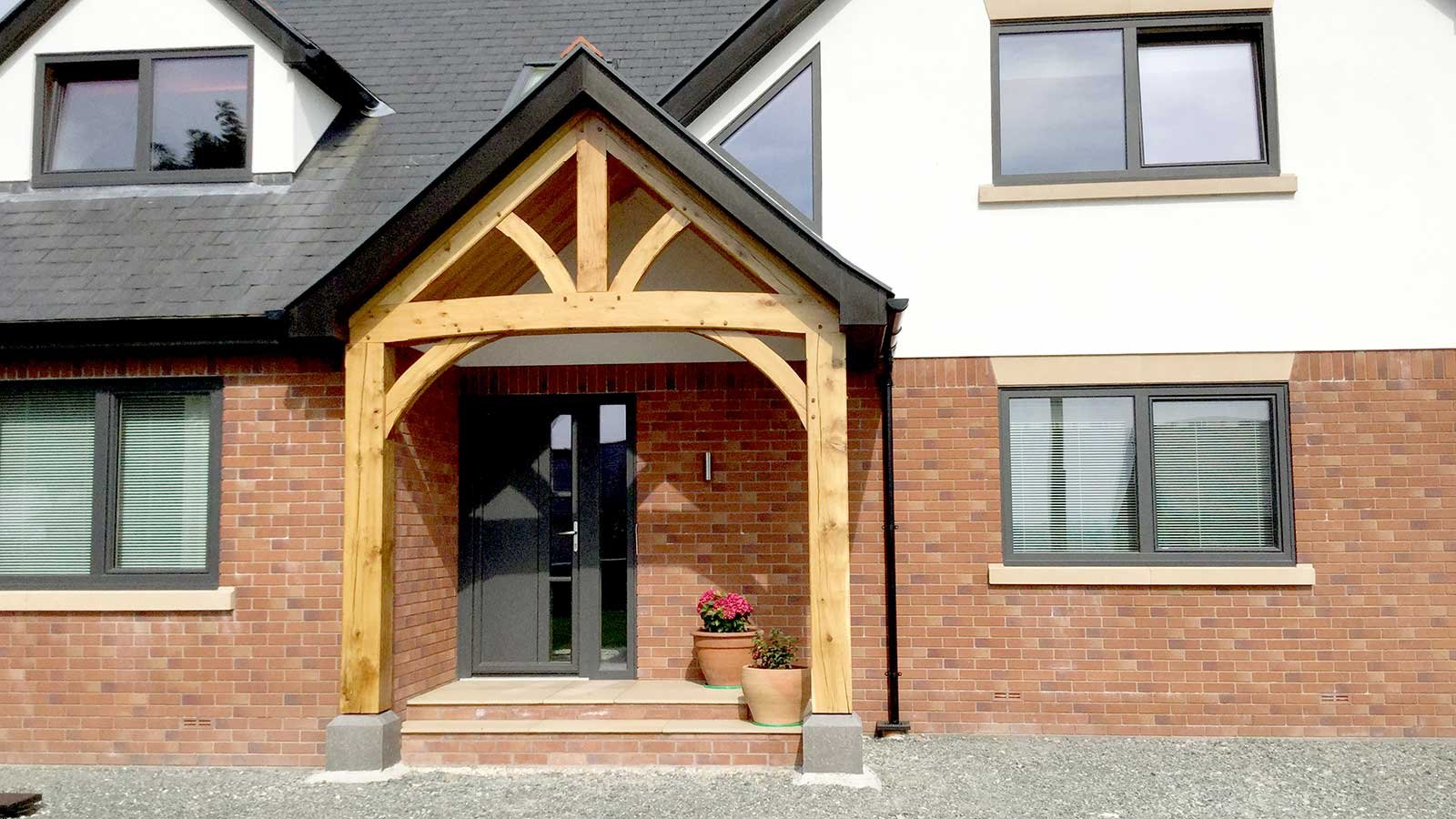
oakbydesign
01423 593 794


Jon approached Oak By Design in June 2017. He was in the process of completing a self-build home in Anglesey and required an oak porch to sit within the corner area in front of his front door. He needed a large truss, two front posts, one return, three curved brackets, a ridge post and rafters. However, he wanted them to be chunky as it was a large area and he wanted them to be proportionate to the rest of the house.
He wanted a slight curve to the tie beam on the 3 metre wide truss and curved braces within the front of the truss. These were to match the curved ones on the face of the oak truss, and the one on the return side of the porch.
After some liaising between Richard and Jon, they agreed on the timber sizes for all the component parts. Once decided, drawings were sent out to Jon for approval.
The timbers used for the front leg posts were a hefty 250mm x 250mm, but these gave Jon the look he wanted.
The side return finished at 225mm x 120mm to give the impression of a chunky beam but without the weight of a full beam.
The kingpost on the main truss was 190mm wide and again 120mm deep.
The overall height of the porch is nearly 3900mm.
Due to the weight of the oak porch, it was sent out in as many component parts as possible to assist in the installation.
Although Oak By Design supplied the timbers planed, sanded, and with a stop chamfer to all the main timbers, Jon chose to apply the finish himself after installation.
John is absolutely thrilled with the oak porch, and after he installed it, he supplied a review through www.houzz.co.uk and declared the porch ‘Magnificent!’.
Houzz review link: https://www.houzz.co.uk/viewReview/929578/Oak-By-Design-review
Building an oak porch is a significant investment that requires careful consideration and planning. This article will discuss three key factors to consider when embarking on such a project: architectural compatibility, planning permission requirements, and maintenance considerations.
One crucial factor to consider when building an oak porch is its architectural compatibility with your existing home. It is essential to ensure that the design of the porch harmonises with the overall style and aesthetics of your property. This can be achieved by selecting materials, finishes, and detailing that complement the existing architecture. By doing so, you create a cohesive and visually appealing structure that adds value to your home.
Before commencing any construction work on your oak porch, it is vital to research and understand the planning permission requirements in your area. Different regions have varying regulations regarding the size, height, and location of porches. Familiarise yourself with these guidelines to avoid potential legal issues or delays in your project. Engaging with local authorities or seeking professional advice can help you navigate through this process efficiently.
Lastly, it is crucial to consider the maintenance requirements associated with an oak porch. While oak is a durable material known for its longevity, regular maintenance is necessary to preserve its beauty and structural integrity. This may involve periodic cleaning, treatments such as oiling or staining, and occasional repairs if needed. Being aware of these maintenance tasks beforehand allows you to plan accordingly and ensure that your oak porch remains in optimal condition for years to come.
In the realm of timber, green oak and air-dried oak represent two distinct categories with discernible disparities in their properties. This analysis aims to shed light on the dissimilarities between these types of timber, providing an objective evaluation of their characteristics and potential applications.
One fundamental disparity between green oak and air-dried oak lies in their moisture content. Green oak, freshly derived from felled trees, exhibits a notably high moisture content ranging from 60% to 80%. This high water saturation stems from the recent felling process and subsequent lack of adequate seasoning time. In contrast, air-dried oak undergoes a lengthier natural drying process facilitated by exposure to ambient air conditions. Consequently, it attains a significantly lower moisture content as compared to its green counterpart.
The seasoning process plays a pivotal role in transforming freshly cut green oak into more usable timber with diminished water content. As time progresses, the inherent moisture within green oak gradually evaporates through natural processes such as diffusion and evaporation. Conversely, air-dried oak bypasses this seasoning phase altogether due to its extended exposure to external elements during the drying period.
The variance in moisture content between these two types of timber has profound implications for their stability and susceptibility to movement or shrinkage. Due to its higher moisture levels, green oak is inherently less stable than its air-dried counterpart. It is prone to dimensional changes when subjected to varying environmental conditions such as humidity or temperature fluctuations.
In contrast, air-dried oak's lower moisture content renders it considerably more stable and resistant to movement or shrinkage under similar circumstances. This increased stability makes it an ideal choice for various construction applications where durability and structural integrity are paramount.
Telephone: 01423 593 794
Locksley Park
Blind Lane
Tockwith
YORK YO26 7QJ
Opening Times:
Mon to Fri - 9.00am to 5.00pm
Bank Holidays - Closed
Christmas 2025- TBC
Oak By Design is the trading name of:
Oak By Design Ltd.
Reg Number: 04384416
VAT Number: 664 8012 33